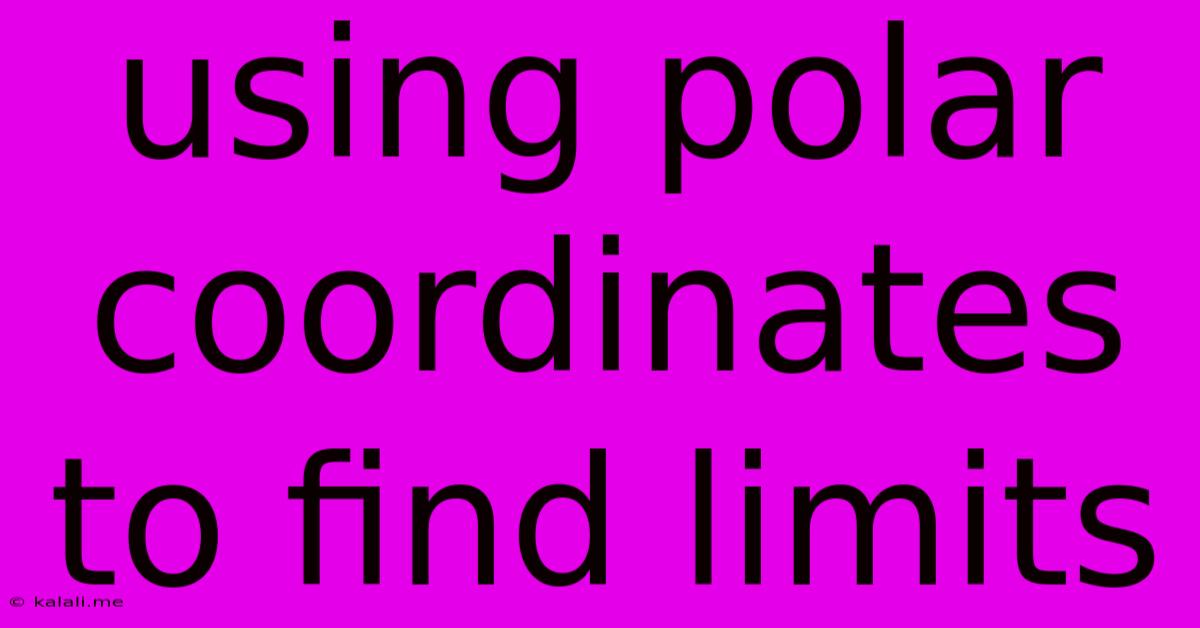Using Polar Coordinates To Find Limits
Kalali
Jun 01, 2025 · 3 min read

Table of Contents
Using Polar Coordinates to Find Limits
Finding limits of multivariable functions can sometimes be tricky, especially when approaching the origin along different paths. This article explores a powerful technique: using polar coordinates to evaluate limits, particularly those involving indeterminate forms at the origin. This method helps circumvent the complexities of approaching (0,0) along various paths, providing a more streamlined and often decisive approach to limit evaluation.
Understanding the Challenge: Different Paths, Different Limits
When evaluating the limit of a multivariable function f(x, y) as (x, y) approaches (0, 0), simply substituting x = 0 and y = 0 isn't always sufficient. The limit might exist only if the function approaches the same value regardless of the path taken to (0, 0). Different paths can yield different limits, signifying the limit does not exist. This makes direct substitution unreliable.
The Polar Coordinate Transformation: A Smoother Path
Polar coordinates provide an elegant solution. We transform the Cartesian coordinates (x, y) into polar coordinates (r, θ) using the transformations:
- x = r cos θ
- y = r sin θ
Where r represents the distance from the origin and θ represents the angle. Crucially, as (x, y) approaches (0, 0), r approaches 0, regardless of the angle θ.
Applying Polar Coordinates to Evaluate Limits
The process involves these steps:
-
Convert to Polar Coordinates: Substitute
x = r cos θandy = r sin θinto the functionf(x, y). -
Simplify: Simplify the resulting expression. The goal is to express the function solely in terms of
r. Often, terms involving θ will cancel out or become insignificant asrapproaches 0. -
Evaluate the Limit: Take the limit as
rapproaches 0. If the limit exists and is independent of θ, then this is the limit of the original function as (x, y) approaches (0, 0). If the limit depends on θ or does not exist, then the original limit does not exist.
Examples: Illuminating the Technique
Let's illustrate with some examples:
Example 1: A Limit that Exists
Consider the limit:
lim (x,y)→(0,0) (x²y) / (x⁴ + y²)
-
Convert to Polar Coordinates:
(r²cos²θ * rsinθ) / (r⁴cos⁴θ + r²sin²θ) -
Simplify:
(r³cos²θsinθ) / (r²(r²cos⁴θ + sin²θ)) = (r cos²θsinθ) / (r²cos⁴θ + sin²θ) -
Evaluate the Limit:
As
rapproaches 0, the numerator approaches 0, while the denominator approaches sin²θ (unless sin θ = 0, which is a specific path). Therefore, the limit is 0.
Example 2: A Limit that Does Not Exist
Consider the limit:
lim (x,y)→(0,0) x / (x + y)
-
Convert to Polar Coordinates:
(rcosθ) / (rcosθ + rsinθ) -
Simplify:
cosθ / (cosθ + sinθ) -
Evaluate the Limit:
The limit depends on θ. For example, if θ = 0, the limit is 1; if θ = π/2, the limit is 0. Since the limit depends on the path (the value of θ), the limit does not exist.
Conclusion: A Powerful Tool in Your Limit-Finding Arsenal
Polar coordinates offer a powerful and often necessary technique for evaluating limits of multivariable functions, particularly those involving indeterminate forms at the origin. By transforming to polar coordinates, we can often simplify complex expressions and determine whether a limit exists and, if so, its value. This method helps overcome the challenges posed by considering multiple paths to the origin, offering a more systematic and efficient approach to limit evaluation. Mastering this technique is essential for a deeper understanding of multivariable calculus and its applications.
Latest Posts
Latest Posts
-
Less Than Equal To In Latex
Jun 03, 2025
-
Why Did Jesus Change Peters Name
Jun 03, 2025
-
How To Fix Crack In Fiberglass Tub
Jun 03, 2025
-
Did Jesus Die On A Tree
Jun 03, 2025
-
When Do You Flip The Sign In Inequalities
Jun 03, 2025
Related Post
Thank you for visiting our website which covers about Using Polar Coordinates To Find Limits . We hope the information provided has been useful to you. Feel free to contact us if you have any questions or need further assistance. See you next time and don't miss to bookmark.